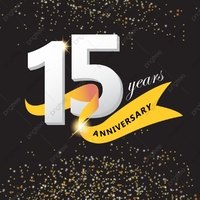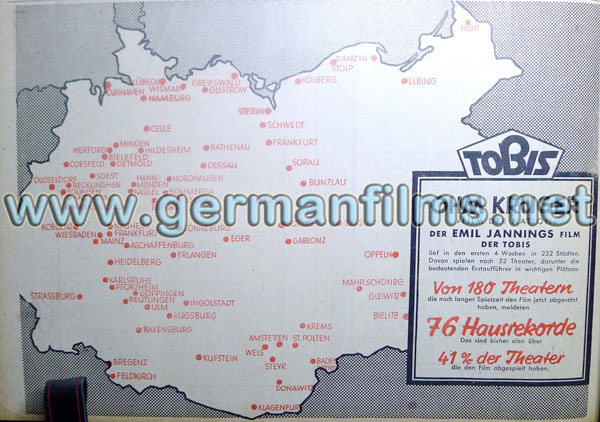Ohm Krüger (Tobis, 1941) - Special Collection
There is but one way in which the opposition of the Boers can be broken and that is by the most severe measures of repression – we must kill the parents in order that their children may have respect for us. ––Winston Churchill, Morning Post (as quoted in Meyer, Eduard; England – Its Political Organization and Development and the War Against Germany, Ritter & Co. 1916
The anti-British film Ohm Krüger, directed by Hans Steinhoff, was the second most costly, elaborate, and lavish feature film made during the Third Reich. It's budget of RM 5.47 million was only surpassed by Münchhausen two years later. Starring the renowned actor Emil Jannings in the title role, with a very strong and huge cast of leading and supporting actors, it depicted the Boer War in South Africa as a merciless British series of war crimes against innocent Boer farmers and their defenseless women and children -- driven by gold, greed and hatred. Kitchener’s brutal use of a concentration camp against Boer civilians sheeted home that this was another perfidious British invention. According to the Film-Kurier Tageszeitung, over 40,000 people were employed in the mass battle scenes. (Scroll below to see a behind-the-scenes photo taken during the organising of the Treck scene which opens the film.)
In the November 30, 1940 issue of the German Library of Information's newsletter, Facts in Review, published in NYC for American readers, an article written by Emil Jannings on the film appeared. This rare newsletter is to be found in our Ohm Krüger collection. We reproduce it here for your edification:
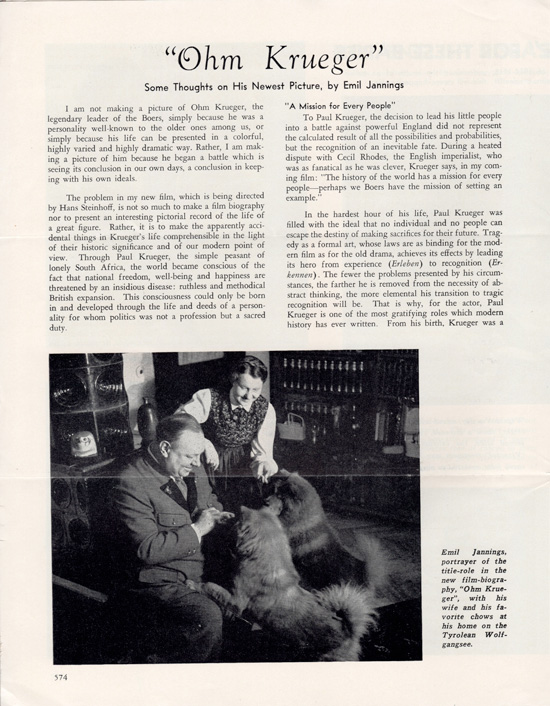
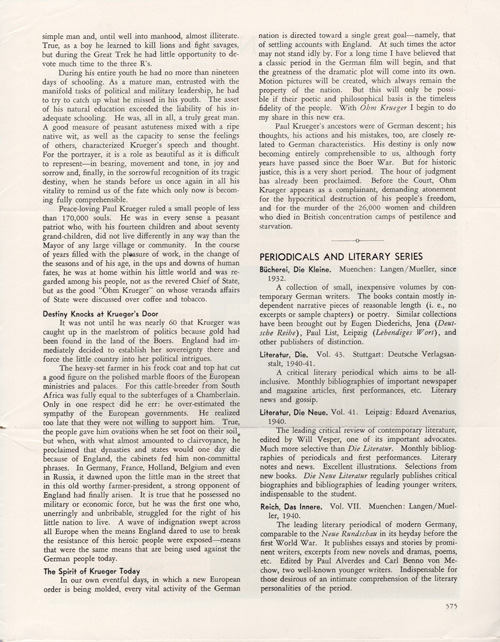
Emil Jannings’ reputation never recovered from this title role portrayal, or for his enthusiastic artistic supervision of this film, and he died a broken man in 1950.
The Gillespie Collection has seven different original posters for this important propaganda film. These include three Tobis film posters for Germany, as well as two from France, and two from Italy.
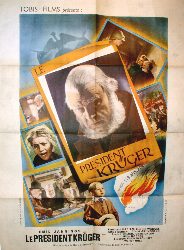

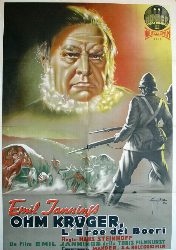
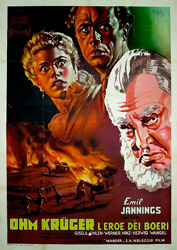
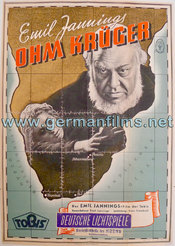
The rare world premiere film program is in the Collection, as well as the Tobis film studio glossy 40-page promotion brochure (we have the German, Italian, the Spanish and the French language editions!), the Tobis pressbook, the Reichsfilmkammer’s flyer on the historical accuracy of the film by Dr. Ziegler; and the original Simplicissmus magazine (shown below) depicting the famous Olaf Gulbransson cover sketch of Jannings as Krüger which was also used (Muster 2) as one of the German posters. Also in the Collection are sixty different original Tobis lobby cards from the film, and five Tobis press photos from both the Rome and Berlin premieres attended by Jannings, Steinhoff, other cast members, and Minister for Propaganda Joseph Goebbels, German and Italian Ambassadors, as well as Benito Mussolini.
The film was designated a "Film of the Nation" by Dr. Goebbels and unprecedented publicity and promotion brought the film to huge audiences both within the Reich and across Europe. Here, for example, is the film studio newspaper advertisement proclaiming that out of 180 cinemas within Greater Germany, in cities and towns alike, no fewer than 41% of them, or 76 cinemas, broke their box office record for paid attendances.
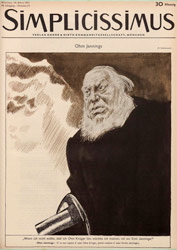

You can read an English translation of the newspaper article on the 1941 television broadcast coverage of the world premiere of the film in Berlin found on this webpage (scroll down...) here.
Director Hans Steinhoff and actor Emil Jannings with the script for Ohm Krüger on the set for the penultimate shattering scene of the film, the British concentration camp where Paul Krüger's wife, son, and other children were murdered; along with over twenty–five thousand Boer women and children during the long Boer War. (Photo from Der Deutsche Film.) In the concentration camp scenes, the brutal Commandant was played by then 48 year old German actor Otto Wernicke, who was purportedly made to resemble Winston Churchill (although the "likeness" is somewhat forced, at best, and Churchill was a much younger 25 year old soldier in the Boer War in fact.) The use of this artifice was certainly meant to remind cinema–goers that Churchill fought against the Boers and enthusiastically supported the War as a geat adventure, including the concentration camps devised by Kitchener.
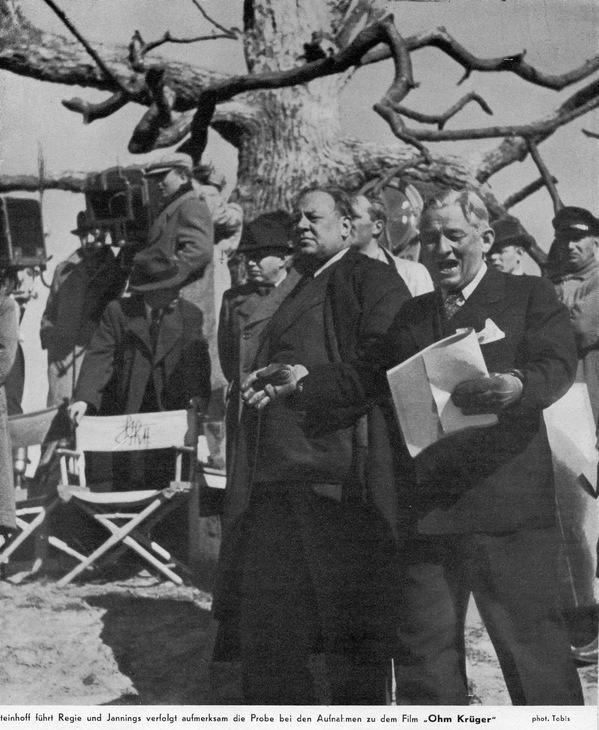
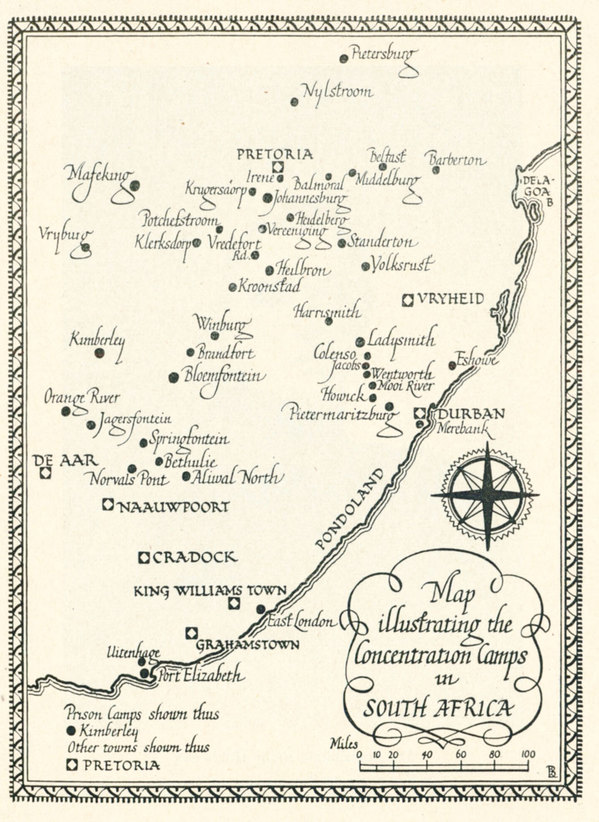
Below, a contemporary photo of a malnourished Boer child in a British concentration camp. Over 26,000 Boer white women and children died during the Boer War in British camps, as well as over 10,000 blacks, thanks to Kitchener's brutal ethnic cleansing war policies to clear the area for the diamond and gold mining land grab for the British Empire.
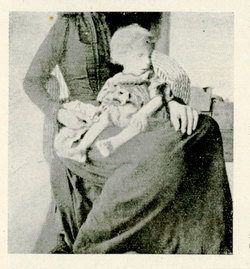
A private photo album compiled by a man who was an extra in the film was acquired by this Collection in January 2013 and has 23 behind-the-scenes snapshots of some of Ohm Krüger's film sets and landscapes constructed outside of Berlin and in eastern Germany by Ufa. An album page showing the British concentration camp sets is shown below.
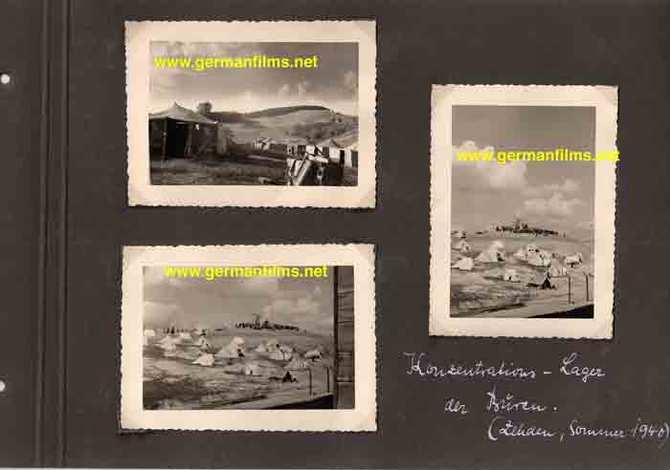
A larger image from the private photo album, of Africans waiting for filming to start. These "extras" were likely a mixture of captured French POWs and/or civilians from pre-WWI German Cameroon who had domesticated in Weimar Germany and were employed by Terra Filmkunst for Ohm Krüger when racial laws gave them little opportunity to work in Nazi Germany.
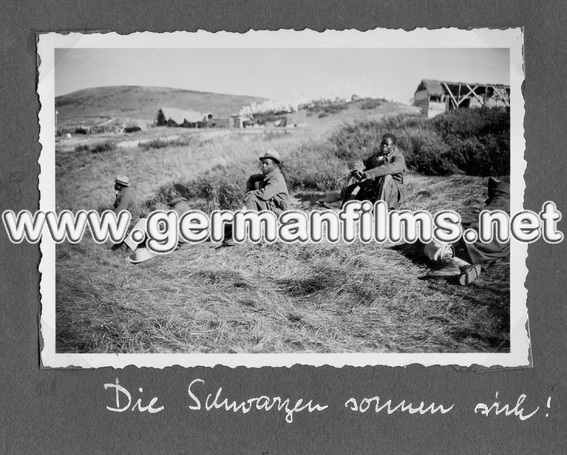
And BELOW, from the same private album, a photograph of Wehrmacht soldiers pasturing horses whilst in the background you can just see the production team organising the personnel and animals for the Great Treck which is depicted at the start of the film in the historical narrative. These private photos were shot by an extra who played a "Tommy" in the film in June 1940 in the area of Zehden, Prussian Germany, about 30 miles N/E of Berlin. The town is today across the Oder River border in Poland. Apologies for the watermarked "German Films Dot Net" on the photo's surface. We have had many rip-offs taken without permission off this site that we must try to protect the rarities in our Collection from exploitation.
The French propaganda effort was unparallelled given the anti–British sentiment already existant in war–torn France after the bombing of the French fleet by Britain and the film provided opportunities for the Germans to exploit this. Here is a french Ohm Krüger comic strip poster (A3 size/approx. 12 inches x 17 inches):
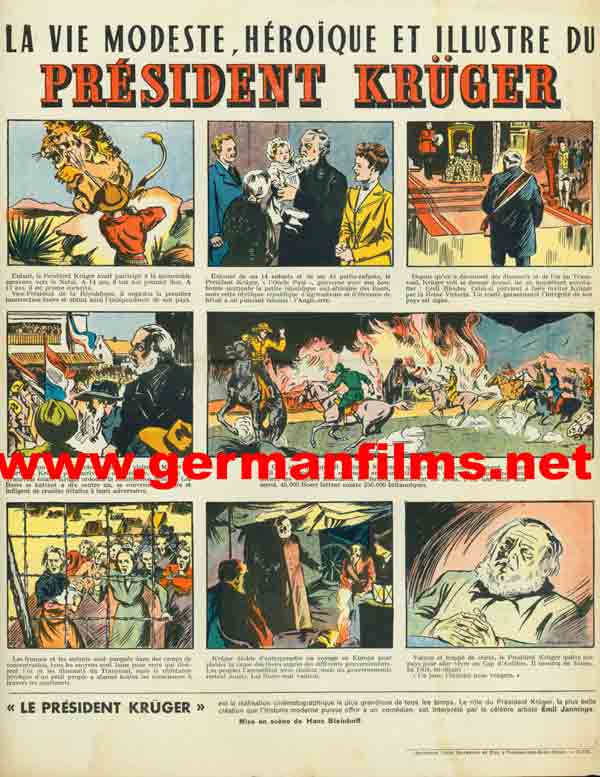
Although there is a pirate version of the film with French subtitles imposed over the German soundtrack version floating around on the Internet, in fact Vichy France only showed the synchronised (i.e. dubbed) version of Ohm Krüger to cinema audiences in 1941/42. This original French version is locked away in the national archives in Paris and researchers are told that the condition of the print is too poor to project, so access is denied. We however obtained a very poor quality VHS tape of the dubbed version and have made it available to a Belgian film historian and professor for a forthcoming article in a scholarly journal. He was delighted to see the French version for the first time, which has a short narration about the Boers and the war at the start of the film inserted for the edification of French audiences. This footage is not in the German version, and has music from the film overlaid with a French narration, footage of battle scenes and a history of the Transvaal. Here we show three screen shots from the original French version:
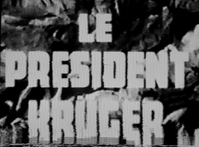

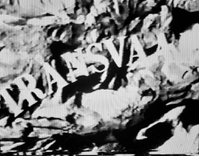
In May 2022 it was made known that an important 24-page article on the French version was to be published later this year in the prestigious Journal of Contemporary History, and we had a critical role to play. It was the French version of the film mentioned above which made this research possible. See our Recent Loans page for details and a link to the journal issue with the article.
The propaganda reach of the film during WWII was quite amazing. In the Philippines, occupied by Imperial Japan, the film was screened in Manila at the Ideal cinema on Riza Avenue, from 29 March 1944. The cinema advertisement for the film in LIWAYWAY magazine that month (shown below) reads in Tagalog
Showing at the Ideal Lyric Cinema from the 29th of March
This is performed by a great German actor Emil Jannings
with the help of Werner Hinz Gizela Uhern.
Here is the portrayal in a film you won't forget.....
the shame, the greediness, the bravery and the suspense
that are strongly performed......
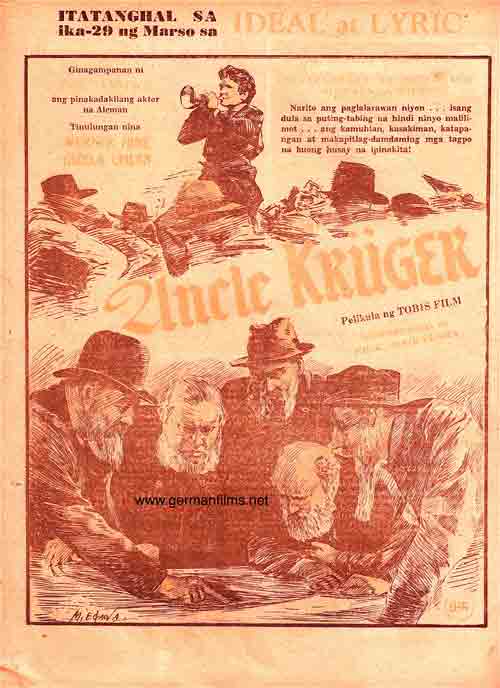
AFTER WWII, the Soviet Union's hostile stance towards the British in Occupied Berlin and elsewhere caused them to release the Steinhoff film in cinemas in the USSR in 1948; despite Ohm Krüger being Nazi propaganda. The film was retitled Transvaal on fire but we can testitfy that it was not cut. We have this Soviet version, which is also dubbed, in a poor quality VHS print. It is astonishing to hear Paul Krüger speaking Russian! Here we present two screen shots of the film's title and a short presentation for Soviet audiences at the beginning of the film about the Boer War. This narration is of course unique to the Soviet film version.
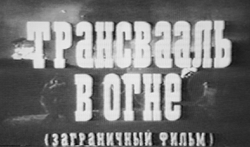
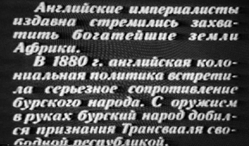
-------- HOLLYWOOD JOKE OF THE YEAR 1943 ---------

This comment from K.M.R.Short's book Film & Radio Propaganda in World War II (Univ. of Tennessee Press, 1983, p.165) has got to be read to be believed! The Hitler Gang is one of the most hokey and inept anti–Nazi motion pictures ever made. With terrible C–cast acting, uniforms which were inaccurate, a silly plot, and cheesy dialogue, along with ridiculous accents and cheap sets.... how Mr. DeSylva ever thought that he could trump Hans Steinhoff and Emil Jannings with this trashy 1943 piece of inept propaganda, we cannot fathom. DeSylva was executive producer of other propaganda films, including the pro-Communist For Whom the Bell Tolls, which he did not direct, and at least had a good cast and script. The reason that the above quote starts off stating something about a pro-Nazi reaction was that at the film's premiere across America many pro-German and isolationist citizens hooted and made fun of the film in public screenings, it was so bad.
------------------------------------------------------------------------------------------------------------------------

